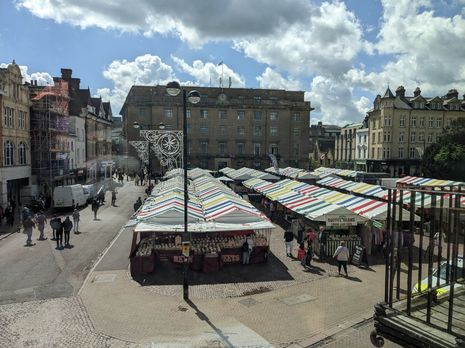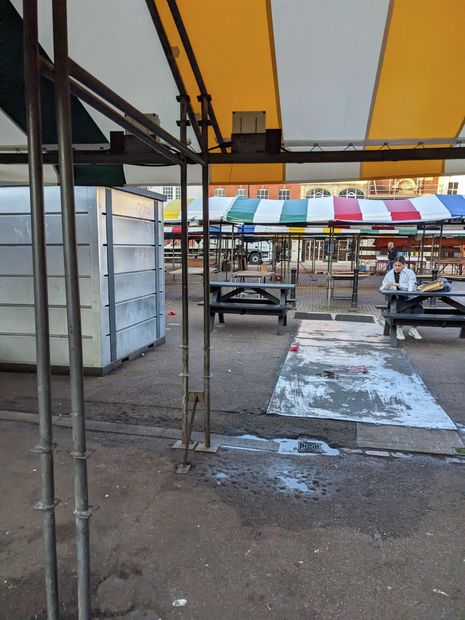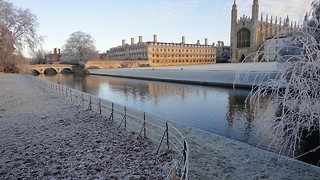Inside Market Square: The beating heart of Cambridge
Nick James goes behind the tarpaulin to spend a day with the stallholders of Market Square

Market Square has been the beating heart of Cambridge since the middle ages. It was here fish, wine, salt, and other exotic luxuries from faraway lands were traded and where the town gathered to witness everything from beheadings to bull-baitings.
Even after a fire in 1849 ravaged the market and the wooden buildings that flanked it, the square was quickly rebuilt with new setts and a central Gothic fountain added. The market’s place as the centre of the city was promptly restored, and residents couldn’t resist the vast array of goods, entertainment, and town gossip the square offered.
“Its ability to inject life and character into a place that already has a rich history is truly impressive”
While there are no longer any beheadings or bull rings, new and creative stalls continue to attract people from all corners of the city. When I first visited Cambridge, I was quickly drawn to the vibrant buzz of the market. Its ability to inject life and character into a place that already has a rich history is truly impressive. But what does it take to produce this buzz that has kept the market square popular for so long? Fortunately, some of the current market stall owners were kind enough to let me peek behind the tarpaulin for the day and find out for myself.
It’s 7.30 on a sunny Thursday morning: I arrive (albeit quite tired) at Market Square to investigate what it’s like working at this historic place. While most students are fast asleep, recovering from a night at Wednesday Revs or a late study session, the square is already filling up as cars and vans start to roll in to unpack everything for the day.
Trading doesn’t normally start until 10, but most stalls take at least two hours to set everything up. Loaves of bread are meticulously positioned in the bakery stands, vibrant arrays of plants are placed at the edge of the florist’s, and pictures are hung in the art stalls to create impressive displays.
The day has barely started, but a significant amount of work has already been done to turn a quiet and lifeless square into a place teeming with vivid colours, eye-catching objects, and interested onlookers. At 10 in the morning, the main event begins. Steady trickles of tourists, locals, and students begin to fill the market as the sun’s rays slowly grow stronger.
“Trickles of tourists, locals, and students begin to fill the market as the sun’s rays slowly grow stronger”
As the first sales of the day take place, I meet with Derek, instantly recognisable from his customary brown apron and wispy white hair. He is the owner of Earth’s Crust, a bread stall that sells a variety of loaves. One of the first things I notice when speaking to Derek is how strong some of his relationships are between him and his regulars. After only speaking with him for a few minutes, our conversation is interrupted by a woman, who rushes up to the baker with child-like excitement and asks: “Is it here yet?”
“It’s only Thursday!” Derek replies.
“Ah of course,” the woman says, looking slightly disheartened, “I’ll be here for that loaf tomorrow then!”
Looking around the market, I see that Derek isn’t the only one with dedicated fans: some stall owners are already having long and friendly conversations with customers – exchanging updates about each other’s lives and discussing the news. For Derek and many others, this is an important part of their business: having meaningful conversations and creating close relationships is what makes the market unique and encourages people to return.
After Derek sells some loaves and cheese twists to some very happy customers, I ask him about his story. There is a glint in his eye as he explains the evolution of Earth’s Crust. The stall had not always been at Cambridge, and at one point he had even sold at my hometown of Croydon. However, our conversation is quickly interrupted by yet another eager customer – one more thing I learned quite swiftly was that there are few breaks for chats during trading hours.
“I learned quite swiftly was that there are few breaks for chats during trading hours”
Before long it’s lunchtime and the market is in full swing: the fishmongers are having to shout over the sizzling woks and barbecues; the smell of fried halloumi has begun to infect the whole market air, and the excited murmurs of shoppers grow ever louder.
Derek capitalises on this increase in footfall by going on a charm offensive, smiling politely at passers-by, and engaging in polite conversation with those who seem interested in his bread. Periodically, the baker walks down the market aisle to talk to his fellow stallholders and find more potential customers.
I then walk through the crowd at the centre of the market to speak to Edward who owns the Pocket of Art. He is far newer to the square, opening in 2019. Interestingly, before he was inspired to open his stall, he was the Chaplain to Great St Mary’s Church.
For Edward, running his stall is mostly about painting, which he does throughout the day to draw people in and show them the creative process. Despite never having worked at another market, Edward has attended arts and crafts fairs across the borough. He tells me he enjoys the more relaxed atmosphere at this market. When I asked Edward what advice he would give to a new stallholder starting in the market square, he replied:
“Don’t expect it to be an immediate success, it takes time to build up a profile and reputation. It’s a great atmosphere and a sense of community, but be prepared for all kinds of weather, often on the same day!”
I mill around for a bit longer, but many of the stalls remain lush with customers and owners who are too busy to chat. The final stallholder I speak to is Julia, owner of Emerald Foods, which sells unique blends of tea and coffee. Just before I interview her, I run into a friend at the market who joins me for the conversation. My friend is keen to try some of Julia’s products, and asks her what the vanilla tea tastes like, a question that leaves Julia unimpressed. She simply replies, “What do you think?”
“I ask her what it’s like to run a market stall in Cambridge and she quickly responds: ‘Being sarcastic to university students and getting away with it’”
Despite my friend’s not-so-good first impression, Julia is still happy to talk. I ask her what it’s like to run a market stall in Cambridge and she quickly responds: “Being sarcastic to university students and getting away with it.” My friend giggles nervously.
We continue the conversation and I ask what sells best, Julia says that loose-leaf teas and coffee beans are often the most popular products and adds: “Our stall is often called ‘the stall of temptation’ by our regular customers and it’s very rare that someone will come to buy one product and leave with just that one thing.”

Although running a market stall can be tough (Julia describes an average day as 12 hours long with no time for a break), she says that she loves running her stall. “Every single day there is a new interaction with a customer which is memorable. One of the best things about being a market trader is having banter with the customers. We meet so many people from all walks of life every day, and that for me is the best part.”
Yet Julia warns, running a stall is no easy feat – your heart has to be in it 100% and you have to be tough. I thank Julia for her time while my friend buys some of her cherry tea (which he later described as “delicious”).
The sound of St Mary’s church bells at four o’clock mark the end of the trading day. The stallholders begin to pack up after another successful day. The square, formerly full of customers and products, quickly transforms from a buzzing hub into a vacant space, ready for everything to be set up again tomorrow.
As the stallholders’ cars roll out of the square, the Trailer of Life van rolls in, marking the end of a busy day and the beginning of what I’m sure will be a very busy night.
 Comment / Anti-trans societies won’t make women safer14 November 2025
Comment / Anti-trans societies won’t make women safer14 November 2025 News / Controversial women’s society receives over £13,000 in donations14 November 2025
News / Controversial women’s society receives over £13,000 in donations14 November 2025 News / John’s rakes in £110k in movie moolah14 November 2025
News / John’s rakes in £110k in movie moolah14 November 2025 Fashion / You smell really boring 13 November 2025
Fashion / You smell really boring 13 November 2025 Music / Three underated evensongs you need to visit14 November 2025
Music / Three underated evensongs you need to visit14 November 2025









